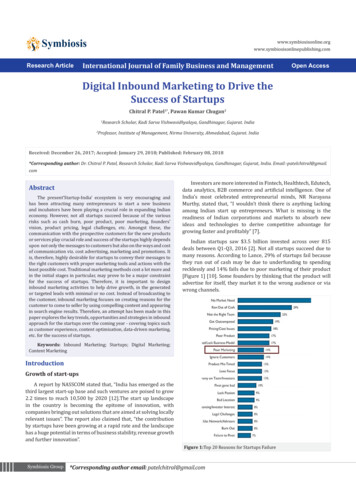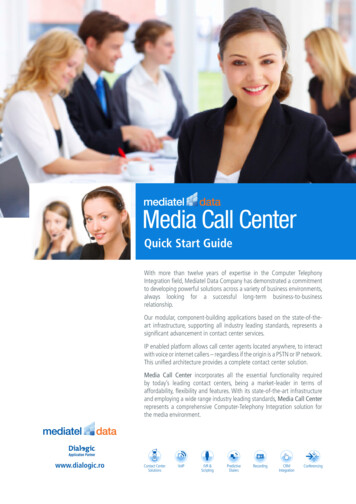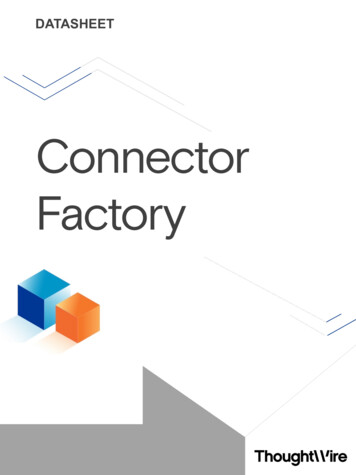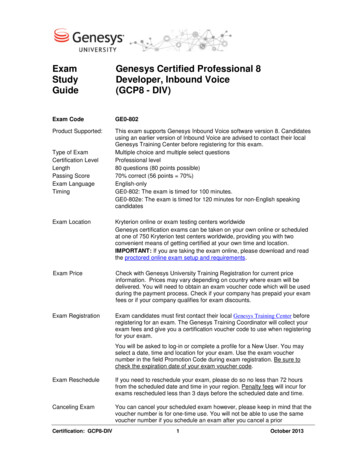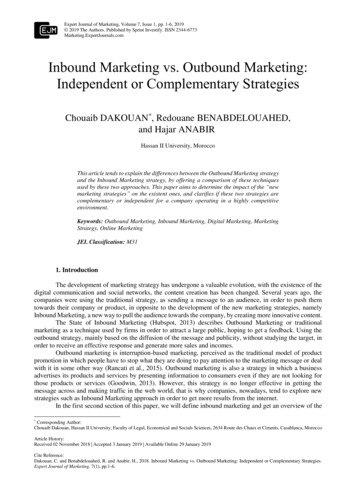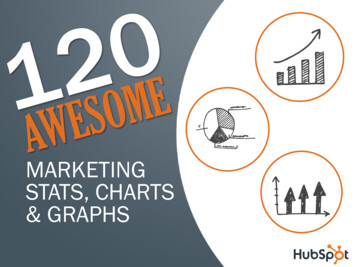
Transcription
www.HubSpot.comThe 2011 State ofInbound MarketingFebruary 2011Tweet This!
THE STATE OF INBOUND MARKETINGContentsIntroduction . 3The State of Marketing Costs & Budgets . 4Inbound Channels Convert Leads into Customers . 10What‘s Important to Marketers? . 13Conclusion and Additional Resources. 16Appendix. 17HubSpot.com2
THE STATE OF INBOUND MARKETINGIntroductionSummaryThis report is based on a January 2011 survey of 644 professionals familiar with their business‘marketing strategy.1 The key takeaways are: Inbound marketing channels are maintaining their low-cost advantage: Inboundmarketing-dominated organizations experience a cost per lead 62% lower than outboundmarketing-dominated organizations.The gap between spending on inbound vs. outbound continues to widen: In 2009,inbound marketing had a 9% greater share of the lead generation budget; in 2011 its sharewas 17% greater.Blogs and social media channels are generating real customers: 57% of companiesusing blogs reported that they acquired customers from leads generated directly from theirblog.More and more business are blogging: Businesses are now in the minority if they do notblog. From 2009 to 2011 the percentage of businesses with a blog grew from 48% to 65%.Businesses are increasingly aware their blog is highly valuable: 85% of businessesrated their company blogs as ―useful,‖ ―important‖ or ―critical;‖ a whopping 27% rated theircompany blog as ―critical‖ to their business.Overview of Inbound MarketingThis report is designed to help businesses and marketers understand the current usage and results ofinbound marketing. Inbound marketing is a set of marketing strategies and techniques focused onpulling relevant prospects and customers towards a business and its products. Inbound marketing isbecoming widely accepted because it complements the way buyers make purchasing decisionstoday—they are using the Internet to learn about the products and services that best meet their needs.Inbound marketers offer their audiences useful information and tools to attract these people totheir site, while also interacting and developing relationships with individuals on the Web. Inboundmarketing tools include blogging, content publishing, search engine optimization and social media.Inbound marketing contrasts with traditional outbound marketing, in which businesses push theirmessages at consumers. With techniques that include direct mail, telemarketing and trade shows,outbound marketing has become less effective over time as buyers have behaviorally andtechnologically (e.g., TIVO, spam filters, ‗do-not-call‘ lists) tuned these interruptive campaigns out.1For more information about the survey please see the appendix.HubSpot.com3
THE STATE OF INBOUND MARKETINGThe State of Marketing Costs & BudgetsInbound Consistently Delivers a Cost per Lead Dramatically Lower Than OutboundSurvey participants were asked to report the distribution of their spending and their average cost perlead. Respondents who spend more than 50% of their lead generation budget on inbound marketingchannels report a significantly lower cost per sales lead than those who spend 50% or more of theirbudgets on outbound marketing channels: In 2011, the average cost per lead for outbound-dominated businesses was 373, whileinbound businesses reported their leads cost on average 143.Inbound marketing-dominated organizations experience a 62% lower cost per leadthan outbound marketing dominated organizations. This finding is remarkably consistent from year to year. The previous study showed strikingly similarresults: the 2010 survey showed that inbound marketing-centric organizations experienced a 60% lowercost per lead.Average Cost Per LeadInbound vs. Outbound 400 373 332Avg. Cost per Lead62% Lower Cost per Lead 200 134 143Outbound MarketingDominatedInbound MarketingDominated 02010HubSpot.com20114
THE STATE OF INBOUND MARKETINGThree Out of Four Inbound Channels Cost Less than Any Outbound ChannelWhen asked to classify each lead generation category as ―below average cost,‖ ―near average cost,‖ or―above average cost,‖ businesses consistently ranked inbound marketing channels as having costslower than outbound channels. PPC was the only inbound channel that was ranked among theoutbound channels. Blogs, social media and organic search maintained the top slots as least expensive.Blogs had the highest instance of being reported as ―Below Average Cost:‖ 55% ofcompanies who blog indicated leads from this channel were ―Below Average Cost.‖Trade shows, PPC, direct mail and telemarketing were most frequently ranked as moreexpensive.Below Average Cost per Lead,% Respondents by Lead Channel60%Outbound% of RespondentsMajority reported blog leads are ocial MediaSEO(Organicsearch)Telemarketing Direct MailPPC(Paidsearch)TradeShows% of RespondentsAbove Average Cost per Lead,% Respondents by Lead ChannelTrade Shows were most frequentlyreported as more expensive than 13%SEO(Organicsearch)Social Media9%0%Trade ShowsHubSpot.comPPC(Paidsearch)Direct Mail TelemarketingBlogs5
THE STATE OF INBOUND MARKETINGThe Majority of Businesses Are Increasing Their Inbound Marketing Budgets―How does your 2011 Inbound Marketing budget compare to your 2010 budget?‖ the survey asked. ―Ifyour 2011 inbound marketing budget changed from your 2010 budget, what drove that decision?‖ Theanswers to these questions show that the majority of businesses are consistently increasing inboundmarketing budgets: 54% of those surveyed are increasing their inbound marketing budgets.89% are either maintaining or increasing their inbound marketing budgets.This increase was observed two years in row.Among the 54% of respondents with increased inbound marketing budgets, the mostcommonly cited reason was ―past success with inbound marketing.‖The majority of businesses attributed their decreasing budgets to the ―economicconditions‖ (71%) or ―a change in management‖ (15%). How does your Inbound Marketing budget for the current yearcompare to your budget for the previous year?% of Respondents60%Majority reported increases in inboundbudgets two years in a row.40%2010201154%51%20%37%35%12%11%0%HigherNo ChangeWhy Businesses are IncreasingInbound BudgetsPast Successwith InboundWhy Businesses are DecreasingInbound BudgetsEconomy50%OtherLower21%71%Change inManagement15%11%Economy15%OtherChange inManagement14%Past Successwith Outbound3%Past Successwith Inbound0%Past Successwith Outbound0%0%20%40%% of RespondentsHubSpot.com0%25%50%% of Respondents6
THE STATE OF INBOUND MARKETINGDistribution of Budgets Continues to Shift To Inbound ChannelsWe asked survey respondents what percentage of their lead generation budgets would be spent oneach of 9 marketing channels: ―direct mail,‖ ―telemarketing,‖ ―trade shows,‖ ―email marketing,‖ ―PPC(paid search / AdWords),‖ ―SEO (organic / natural search),‖ ―social media,‖ ―blogs,‖ and ―other.‖ Thosenine channels were grouped as follows (email marketing can be used both as an inbound and anoutbound marketing tool so it was not classified):INBOUND CHANNELSOUTBOUNDCHANNELSNOTCLASSIFIEDPPCDirect MailEmail MarketingSEOTelemarketingOtherSocial MediaTrade ShowsBlogsThe results show that: The average portion of budget dedicated to inbound increased from 38% to 41% from 2009to 2011.The net effect is that the gap continues to widen - inbound marketing had a 9% greatershare of the lead generation budget in 2009 in comparison to a 17% greater share in2011.Lead Generation BudgetAverage Distribution, 2009 v. 201140%9% gapOutbound17% gapAvg % of BudgetInbound20%41%38%29%24%0%2009HubSpot.com20117
THE STATE OF INBOUND MARKETINGA more granular view of the data shows that: Inbound Lead Generation BudgetAverage Distribution, 2009-201150%PPC40%Avg % of Budget Marketers are allocating more of their lead generation budgets to social media and companyblogs.The average budget spent on company blogs and social media increased from 9% in 2009 to17% in 2011.Marketers are decreasing the portion spent on PPC, direct mail and telemarketing.11%30%10%SEO (organicsearch)16%13%13%20%Blogs & SocialMedia13%10%15%18%9%0%200920102011Outbound Lead Generation BudgetAverage Distribution, 2009-201140%Avg % of Budget Telemarketing10%6%20%5%Trade ShowsDirect Mail11%11%13%9%7%6%0%2009HubSpot.com201020118
THE STATE OF INBOUND MARKETINGSmall Companies Continue to Spend More of Their Budgets on Inbound MarketingIn a continuation of a trend identified in previous reports, small businesses are attempting to level theplaying field by focusing on lower-cost inbound lead generation techniques. In 2011, small businesses (1 to 5 employees) plan to spend 49% of their lead generationbudgets on inbound marketing.In comparison, medium-to-large businesses (50 or more employees) only plan to spend 36% oftheir lead generation budgets on inbound marketing.Small business are only giving 10% of their budget to outbound, while medium-to-largebusiness are allocating 28% of their budget to outbound channels.Small businesses plan to spend dramatically more of their budgets on social media and blogs.Medium-to-large businesses plan to spend more of their budgets on outbound methods,including trade shows, direct mail and telemarketing.Avg. Distribution of Lead Generation BudgetsSmall vs. Medium to Large Businesses20%19%1 to 5 EmployeesAvg % of Budget16% 17%13%Over 50 Employees13%12%10%10%10%8%7%6%4%3%3%3%3%0%Social ingTrade ShowsPPC(Paid Search)Direct MailTelemarketing9
THE STATE OF INBOUND MARKETINGInbound Channels Convert Leads into CustomersSocial Media and Blogs Generate Real CustomersThe use of social media and company blogs as marketing tools not only gets your company betterbrand exposure, but it also generates leads that result in real customer acquisition. 57% of those using company blogs have acquired a customer from a blog-generated lead;this is an increase of 11 percentage points since 2010.Similarly, 57% of companies using LinkedIn have acquired a customer from that channel.Facebook and Twitter users reported customer acquisition rates of 48% and 42%,respectively.Customer Acquisition by Channel60%57%57%48%44%46%% of ChannelUsers whoAcquired aCustomerThrough thatChannel41%41%42%40%2010201120%0%Company BlogLinkedInFacebookTwitterCustomer Acquisition through Blogs is Directly Related to Frequency of PostsIf your blog is underutilized, you are leaving customers on the table. The 2011 survey shows a directcorrelation between blog post frequency and new customers acquired.Blog Post Frequency vs. Customer Acquisition100%89%72%% of BlogUserswho Acquireda customer50%throughtheir blog76%78%2-3 Timesa WeekDaily49%33%0%Less ThanMonthlyMonthlyWeeklyMultipleTimes aDayFrequency of Blog PostsHubSpot.com10
THE STATE OF INBOUND MARKETINGMost Company Blogs Publish at Least WeeklyDespite the evidence showing that increased blogging correlates with increased customer acquisition,blogging frequency remained relatively steady between 2009 and 2011. In 2011, 71% of respondents indicated they blog at least weekly.Frequency of Blog Posts2009 v. 201180%% of ilyWeeklyMonthly or lessFacebook Is More Effective for B2C; LinkedIn Is More Effective for B2BThe effectiveness of a particular social media channel depends upon the type of business. While bothB2B and B2C companies are able to acquire customers through any of the four channels surveyed,Facebook is clearly more effective for B2C businesses and LinkedIn is clearly more effective for B2Bbusinesses. Both business types found similar and relatively high success with customer acquisitionthrough a company blog.Customer Acquisition by ChannelB2B v. B2CB2B80%60%% of ChannelUsers whoAcquired aCustomerThroughthat HubSpot.comCompany BlogFacebookTwitter11
THE STATE OF INBOUND MARKETINGChannel Effectiveness by IndustryA deeper dive into the customer acquisition results shows how the effectiveness of blogs, Twitter,Facebook and LinkedIn varies by industry. The major takeaways from this data include: Higher Education, Professional Services & Consulting, and Software & Biotech found bloggingwas highly effective. All of those industries had over 50% of respondents indicating customeracquisition through their blog.The Retail industry experienced the most success through Facebook and Twitter.Communications & Media, Banking/Insurance/Financial Services, Manufacturing, ProfessionalServices & Consulting, and Technology Hardware found LinkedIn was highly effective.Customer Acquisition by Channelby Industry61%Banking/Insurance/Financial er ional logy (Hardware)Technology (Software/Biotech)58%0%20%40%60%80%100%% of Channel Users who Acquired a CustomerThrough that ChannelHubSpot.com12
THE STATE OF INBOUND MARKETINGWhat’s Important to Marketers?Inbound Marketing Channels Continue to Grow in ImportanceBased on the data regarding customer acquisition and lower average costs for inbound marketing, it isnot surprising that inbound marketing channels continue to grow in importance. Looking at the last sixmonths: 62% of businesses rated social media as being more important.Social media and SEO were the channels most frequently reported as MORE important.Direct mail was the channel most frequently cited as LESS important.Businesses rated every outbound channel as LESS important than any inbound channel.Which sources of leads have become MOREimportant to you over the last six months?70%62%% of 20%11%10%10%0%Social MediaSEO(Organicsearch)BlogsPPCTrade Shows Telemarketing(Paid search)Direct MailWhich sources of leads have become LESSimportant to you over the last six months?60%50%% of 10%10%7%0%Direct ch)BlogsSEO(Organicsearch)Social Media13
THE STATE OF INBOUND MARKETINGBlogs Remain Most Important Social Media ChannelSurvey respondents were asked to indicate if theirbusiness publishes a blog. From 2009 to 2011, thevolume of respondents indicating that theircompany publishes a blog has shown rapidgrowth: 100%% of Repsondents Do you publish a company blog?From 2009 to 2011, the percentage ofrespondents with a company blog grewfrom 48% to 65%.On the flip side, the likelihood of a nothaving a blog has been reduced from 52%to dents were also asked to rank the services that they use as ―critical,‖ ―important,‖ or ―useful.‖The results indicate: A whopping 27% of users rated their company blog as “critical” to their business.85% of users rated company blogs as “useful” or better.LinkedIn, YouTube, Facebook and Twitter were considered ―useful‖ or better by over 60%.In contrast, MySpace, StumbleUpon, Digg and Flickr all had user bases where over 70%considered the channel only ―somewhat useful‖ or ―not useful.‖How important are these services to your business?27% reported their blog was “Critical”.Company krUsefulDiggSomewhat UsefulStumbleUponNot UsefulMySpace0%20%40%60%80%100%% of UsersHubSpot.com14
THE STATE OF INBOUND MARKETINGCompany Blogs, YouTube, Facebook and Twitter Increasingly Valued by BusinessesThe results of both the 2009 and 2011 studies reveal that certain channels are gaining importance overtime. The graph below shows the percentage of users who rated the channel as either ―critical‖ or―important‖ in 2009 and 2011.The results of this comparison show: Company blogs are increasingly valued. The blog is the channel most frequentlyreported as critical or important, both in 2009 and 2011.YouTube, Facebook, and Twitter are also increasingly important. Facebook and Twitter gainedan additional 18%, and YouTube gained 20%.Flickr, Digg, StumbleUpon, and MySpace had reduced importance.% Respondents indicating Channel was Critical or Important2009 vs. 2011Gaining Importance62%60%% of cebookTwitterFlickrDiggStumbleUponMySpace15
THE STATE OF INBOUND MARKETINGConclusion and Additional ResourcesTraditional outbound marketing techniques – including direct mail, print advertising and telemarketing –are becoming less effective. Buyers are not only finding ways to tune these messages out, but moreimportantly, they now have the capability to evaluate the products and services they need on their own.As a result, businesses are transforming their marketing efforts to focus more on inbound programs thatallow customers to find them. The State of Inbound Marketing report shows that businesses that moreaggressively practice this are capturing leads more effectively. Given the digital nature of inboundmarketing, the marginal cost per customer acquisition is typically close to zero, meaning that as buyerscontinue to shift how they make purchasing, the cost per lead for a given business will continue todecrease.While it is clear that businesses are gravitating towards inbound marketing, some are moving moreaggressively than others. Those who move first are more likely to reap the tremendous businessbenefits of this new era of marketing.If you are interested in learning more about inboundmarketing and how to combine blogging, SEO and socialmedia for results, try HubSpot‘s free 30-day 16
THE STATE OF INBOUND MARKETINGAppendixWe asked respondents to name the best and worst marketing programs they‘ve executed to drive leadsand sales over the past year. Represented below are their answers in a word cloud.Best Things People Did in Marketing Last Year:Worst Things People Did in Marketing Last Year:HubSpot.com17
THE STATE OF INBOUND MARKETINGRespondent ProfilesThe State of Inbound Marketing report is based on surveys conducted in early 2009, 2010, and 2011.The 2011 results are based on responses from 644 professionals who were familiar with their business‘marketing strategy. These professionals included marketers, business owners, entrepreneurs, andexecutives at companies of various sizes. 76% of these professionals worked in business-to-businesscompanies and the range of industries varied greatly. Industries represented in the sample includedRetail, Technology, Professional Services & Consulting, Banking/Insurance/Financial Services andCommunications & Media among others.How many full-time employees does yourcompany have?201 or more17%My business primarily sells to otherbusinesses (B2B) or consumers(B2C)B2C24%1 to 539%51 to 20015%B2B76%11 to 25 6 to 109%12%26 to 508%What industry best describes your company?Other27%Technology19%Retail /Wholesale6%Banking /Insurance /FinancialServices4%Communications / Media14%What best describes your role?BusinessOwner /Partner33%Marketing50%ProfessionalServices /Consulting30%CEO /Executive9%HubSpot.comOther8%18
THE STATE OF INBOUND MARKETINGSample Questions AskedThe survey was designed to collect data on the marketing practices and results for a wide range ofbusinesses. This is the third consecutive year in which this survey has been conducted. Respondentswere asked a series of questions related to their business‘ marketing programs the results they haveseen. Most of the questions fell within three categories:---Marketing budget and sources of leads, including:o What percent of your sales leads come from each of your lead channels?o What percent of your lead generation budget do you spend on each of your leadchannels?o Estimate the cost per lead for each of your lead channels.Trends in ―importance‖ and ―usefulness‖ of marketing channels and leads, including:o Which sources of leads have become MORE important to you over last six months?o Which sources of leads have become LESS important to you over last six months?o How useful are social media sources to your business?Focus on blogs and social mediao Do you publish a blog?o How often do you publish a post?o Have you ever acquired a customer from the following social media / blog channels?HubSpot.com19
Inbound marketing contrasts with traditional outbound marketing, in which businesses push their messages at consumers. With techniques that include direct mail, telemarketing and trade shows, . PPC, direct mail and telemarketing were most frequently ranked as more expensive. 55% 47% 39% 36% 33% 27% 19% 0% 20% 40% 60% Blogs Social Media SEO .



